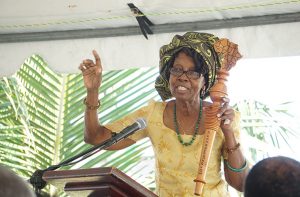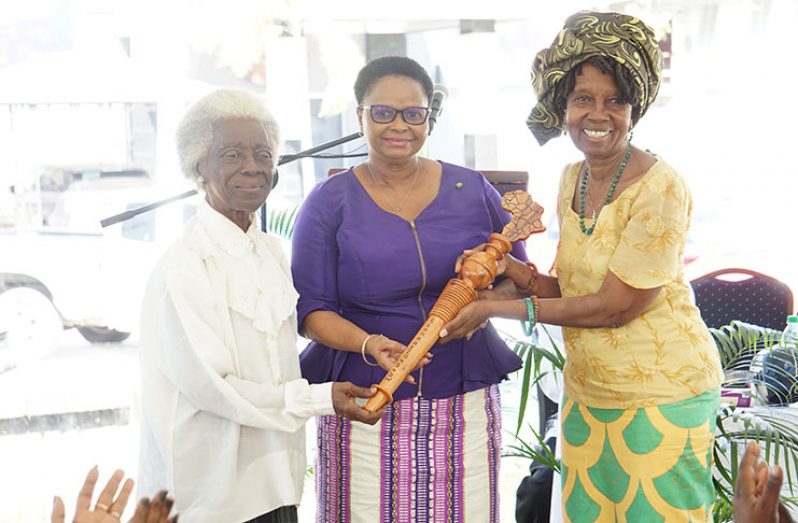ANOTHER step towards the realization of reparation for all Africans was made on Sunday when the Guyana Reparations Committee (GRC) presented a replica of the reparation baton to Minister of Public Health, Hon. Volda Lawrence.
The presentation was made at the 32nd anniversary conference for African Civilization Day observance organized by the Pan African Movement in Guyana, and was held at the Pan African Garden on the Merriman’s Mall, under the theme “Towards the Decade of National Development”.
Presenting the baton on behalf of the Guyana Reparations Committee (GRC) were Penda Guyan and lecturer of the University of Guyana Dr. Joycelynne Loncke.
In her presentation Guyan explained that a duplicate of the original baton was presented, because the original baton had to be run in all 13 CARICOM countries, to bring awareness about the African reparation situation.
Guyan said the baton which was designed by the CARICOM Reparations Council (CRC), was intended to be a symbol to stimulate awareness in African young people and served as a generational transfer of responsibility.
“Guyana is the first country the baton was run in. It was run in Demerara, Essequibo and Berbice and as a result a reparation youth movement was formed in Berbice,” she said.
Why the baton

She further explained the purpose for the baton with seven points.
Firstly, she said that the baton was a tangible object and that it was the sum total of all Africans’ thoughts made concrete. It was also the process leading from the realm of ideas, to the sphere of action.
Secondly, she said the baton denoted a planned destination. She said that it was taken somewhere, but not by the whims and fancies of individualism, but by the planned decisions of the collective.
Thirdly the baton indicated individual commitment and dedication, and individual responsibility and purpose. It was placed into the hands of an individual who was aware of what was to be done. The fourth reason for choosing the baton was that it indicated cooperativeness.
The fifth reason she said was that the baton was not static, but an actual or inferred dynamic symbol that was in constant movement and that movement was progress, organic and life and or living.
The penultimate reason for the baton was that it spoke to the question “Why Reparations?” Guyan explained.
The baton which was made of Mahogany wood, was seen as a symbol of protection, since the story behind the Mahogany trees, she explained, was that the trees were planted in the islands of the West Indies (Caribbean) as windbreakers to protect especially agriculture communities, people and property.
The baton says that Africans in the Diaspora were seeking compensation for labour rendered on the respective Plantations, between the periods of their enslavement and were demanding that, if the laws of the Parliament of the United Kingdom, for example, were sufficient to protect the economic and social interests of the Plantation operators, then those laws did, and must. pertain, to the social and economic interests of Africans who, in terms of the intent and functioning of the Plantation System, were integrally related to that of the Plantation operators.
The final reason for the baton she said, was because it was seen as a beacon for the African message and it drew attention to the African demand.
Also in attendance were Minister of Foreign Affairs Dr. Karen Cummings, His Worship the Major of Georgetown Ubraj Narine and former Mayor of Georgetown Hamilton Green



.jpg)








